|
|
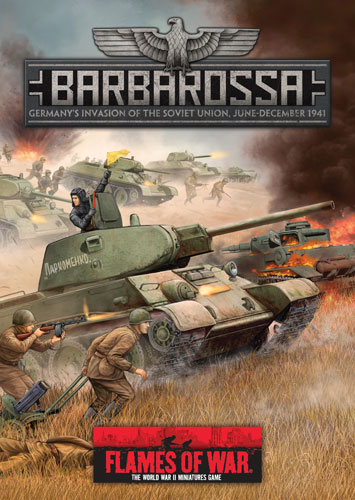 |
Panzers In The East:
The Tanks Of Operation Barbarossa
On 22 June 1941, Germany launched Operation Barbarossa, the invasion of the Soviet Union. The operation threw 3.8 million Axis soldiers across a 2,900 km (1,800 mile) front making it the largest land invasion in the history of warfare.
Facing the Germans were the 5.5 million men and more than 20,000 tanks of the Red Army. Up until this point, the Panzer Divisions had only known victory and this clash would provide their greatest challenge and set-up some of the greatest tank battles in history.
|
The Light Panzers
The rapid expansion of the Panzer Divisions during the early war years meant that tanks that were considered border-line obsolete were pressed into service for the invasion of the Soviet Union. For example, when adequate numbers of the Panzer II were unavailable to equip all of the Panzer Divisions, the Panzer I was forced into service to make up the numbers.
|
Below: The Panzer I B.
|
Below: The Panzer II C. |
Below: The Panzer II F. |
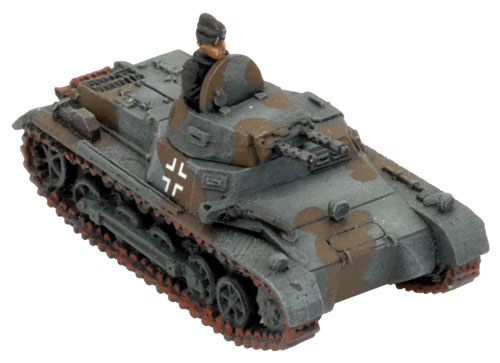 |
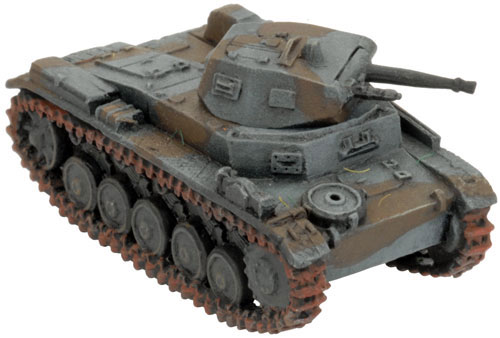 |
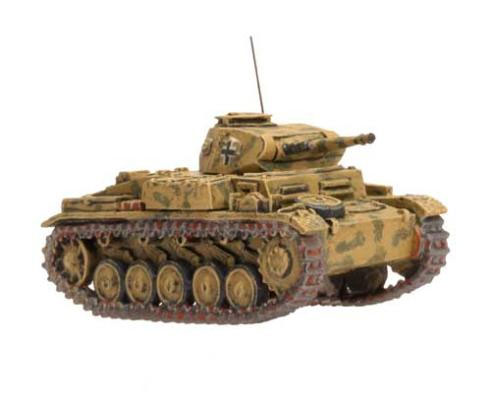 |
While these light Panzers lacked the firepower to deal with any serious armoured threat the enemy could throw at them. They were still effective against infantry and guns.
|
The Light Panzers in Barbarossa
|
| |
|
|
Armour
|
|
|
| Name |
Mobility |
Front |
Side |
Top |
Equipment and Notes |
| Weapon |
Range
|
ROF
|
Anti-tank
|
Firepower
|
|
| Panzer I |
Half-tracked
|
1
|
1
|
1
|
Twin MG.
|
Panzer II C (late)
|
Standard Tank
|
2
|
1
|
1
|
Co-ax MG, Protected ammo.
|
2cm KwK38 gun
|
16"/40cm |
3 |
5
|
5+
|
|
Panzer II F
|
Standard Tank |
3
|
1 |
1
|
Co-ax MG, Protected ammo. |
| 2cm KwK38 gun |
16"/40cm |
3
|
5 |
5+ |
|
|
The Czech Panzers
The Panzer 35(t) served as the main battle tank for the Czech Army
during the year preceding the German annexation in March 1939. Despite
its reputation for unreliability, the stocks of Panzer 35(t) were
readily absorbed into the German Army. The Panzer 35(t) also saw action
during the Polish campaign and the invasion of France in 1940. It
continued to serve in Russia until late winter 1941 by which time most
of the vehicles had been lost.
|
| Below: The Panzer 35(t). |
Below: The Panzer 38(t). |
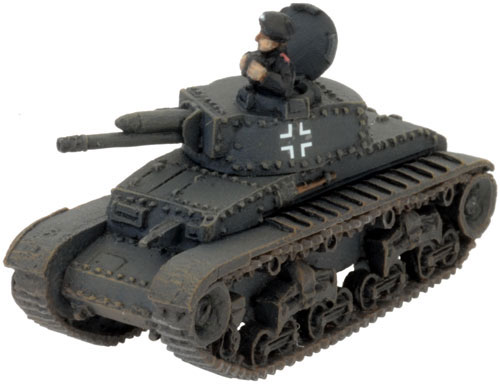 |
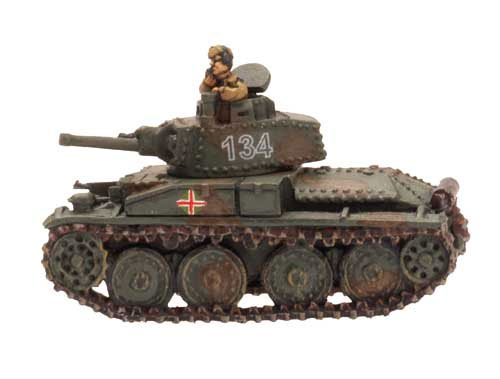 |
| The
Panzer 38(t) proved far more mechanically reliable and enjoyed a higher
degree of mobility than the Panzer 35(t) and performed well against the slower
French tanks and was the equal of the Soviet BT series. However it was totally out-classed by the more modern designs such as T-34 and KV series. |
Panzer 35(t)
Cheap and plentiful, these tanks still pack the same gun as an early Panzer III so you cannot ignore them.
Panzer 38(t)
Just like the Panzer 35(t) these tanks are hardworking and reliable on the table. If Front Armour 2 is not enough you can upgrade them to the Panzer 38(t) E/F and go to Front Armour 3. That might not sound like much but when most enemy guns are Anti-tank 5, 6 or 7 that extra point of armour can be the difference between a dead tank and a living one.
|
The Czech Panzers in Barbarossa
|
| |
|
|
Armour
|
|
|
| Name |
Mobility |
Front |
Side |
Top |
Equipment and Notes |
| Weapon |
Range
|
ROF
|
Anti-tank
|
Firepower
|
|
| Panzer 35(t) |
Standard Tank
|
2
|
1
|
1
|
Twin co-ax MG, Hull MG, Protected ammo, Unreliable.
|
3.7cm KwK34(t) gun
|
24"/60cm
|
2
|
6
|
4+
|
|
Panzer 38(t)
|
Standard Tank |
2 |
1 |
1
|
Co-ax MG, Hull MG, Protected ammo. |
| 3.7cm KwK34(t) gun |
24"/60cm |
2
|
6
|
4+
|
|
|
The Panzer III Series
By June 1941 the main tank of the German Army is the Panzer III armed with the short L/42 50mm KwK38 gun. The 50mm gun is more than capable of dealing with most of the enemy tanks they have encountered during their campaigns in Poland, France, North Africa, and the Balkans. In Russia new models of Panzer III tanks begin to arrive with heavier armour, giving their crews better protection against the new Soviet guns.
|
The Panzer III
The Panzer III G, H and J variants have been resculpted and look better than ever before. The platoon has options to mix up to four different variants of the Panzer III so you can ensure your force can deal with any threat.
|
Below: The Panzer III E.
|
Below: The Panzer III G / H.
|
Below: The Panzer III H.
|
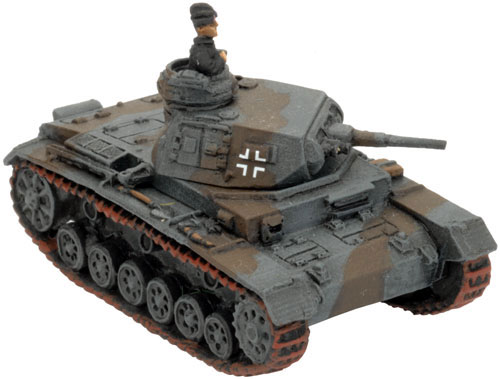 |
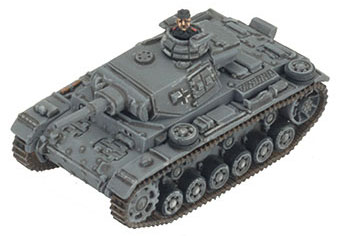 |
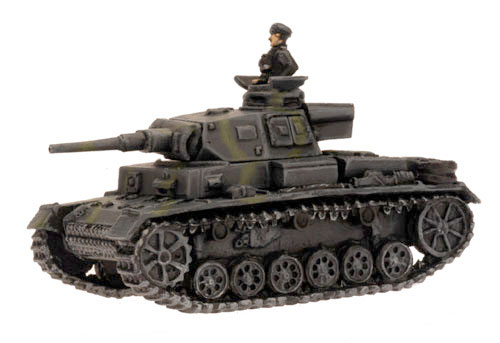
|
| The Panzer III Series in Barbarossa |
| |
|
|
Armour
|
|
|
| Name |
Mobility |
Front |
Side |
Top |
Equipment and Notes |
| Weapon |
Range
|
ROF
|
Anti-tank
|
Firepower
|
|
| Panzer III E or F
|
Standard Tank
|
3
|
3
|
1
|
Twin co-ax MG, Hull MG, Protected ammo.
|
3.7cm KwK gun
|
24"/60cm
|
3
|
6
|
4+
|
|
Panzer III F (late) or G
|
Standard Tank |
3 |
3 |
1
|
Co-ax MG, Hull MG, Protected ammo. |
| 5m KwK38 gun |
24"/60cm |
3
|
7
|
4+
|
|
| Panzer III H |
Standard Tank |
4
|
3
|
1
|
Co-ax MG, Hull MG, Protected ammo. |
| 5m KwK38 gun |
24"/60cm |
3 |
7 |
4+ |
|
| Panzer III J |
Standard Tank |
5
|
3
|
1
|
Co-ax MG, Hull MG, Protected ammo. |
| 5m KwK38 gun |
24"/60cm |
3
|
7
|
4+
|
|
|
The Panzer IV Series
The Panzer IV had the distinction of being the only German tank to remain in production for the entirety of the Second World War. Designed to prove fire support to the lighter tanks with its short 7.5cm gun, its role would change as the war progressed. But during the early stages of the any improvements concentrated on adding more armour protection rather than up-gunning its main armament.
|
The Panzer IV
With three different options you can tailor this company as well, with the added advantage that each of the Panzer IV tanks can fire bombardments!
|
| These vehicles are included in the Early-war Sale. Click on the images above to view each vehicle in the online store. |
| The Panzer IV Series in Barbarossa |
| |
|
|
Armour
|
|
|
| Name |
Mobility |
Front |
Side |
Top |
Equipment and Notes |
| Weapon |
Range
|
ROF
|
Anti-tank
|
Firepower
|
|
| Panzer IV D
|
Standard Tank
|
3
|
2
|
1
|
Co-ax MG, Hull MG, Protected ammo.
|
7.5cm KwK37 gun
|
24"/60cm
|
3
|
7
|
3+
|
Smoke.
|
Firing bombardments
|
48"/120cm
|
-
|
2
|
6
|
|
Panzer IV E
|
Standard Tank |
4 |
3 |
1
|
Co-ax MG, Hull MG, Protected ammo. |
| 7.5cm KwK37 gun |
24"/60cm |
3
|
7
|
4+
|
Smoke.
|
| Firing bombardments |
48"/120cm |
-
|
2
|
6
|
|
Panzer IV F
|
Standard Tank |
5
|
3
|
1
|
Co-ax MG, Hull MG, Protected ammo. |
| 7.5cm KwK37 gun |
24"/60cm |
3 |
7 |
4+ |
Smoke. |
| Firing bombardments |
48"/120cm |
-
|
2
|
6
|
|
|
The Light Tanks
The Red Army uses a great variety of light tanks in their mechanised corps, from old twin machine-gun turreted T-26 obr 1932 to the brand new T-60 light tank. Though lightly armoured most are armed with the excellent 45mm gun. These tanks can concentrate formidable firepower against the enemy, and prove especially effective against enemy infantry and light armour.
The T-26 obr 1932 mounts two small machine-gun turrets on its hull and is designed to provide mobile machine-gun support to the infantry.
The T-26 obr 1933 mounts the excellent 45mm gun in a larger turret, while the T-26 obr 1939 is the final production model with a cast turret and 45mm gun, and could mount a turret rear machine-gun. The final T-26 model is the T-26E, which has been uparmoured with additional armoured plates.
|
Below: The BT-5.
|
Below: The BT-7.
|
Below: The T-26 obr 1933.
|
Below: The T-26 obr 1939. |
Below: The T-38. |
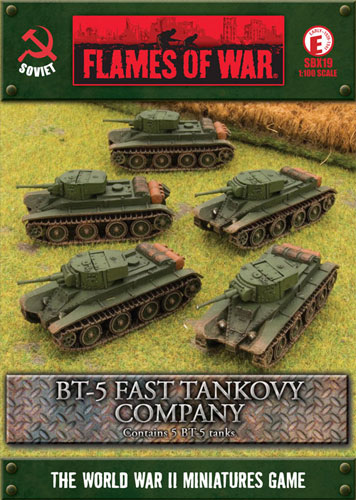 |
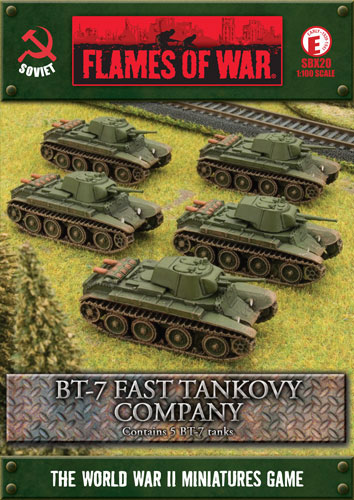 |
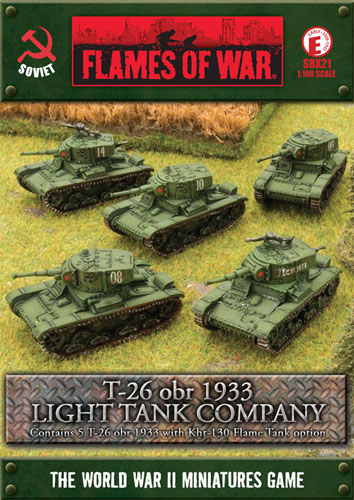 |
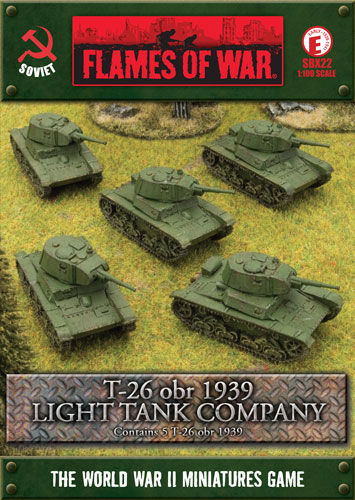 |
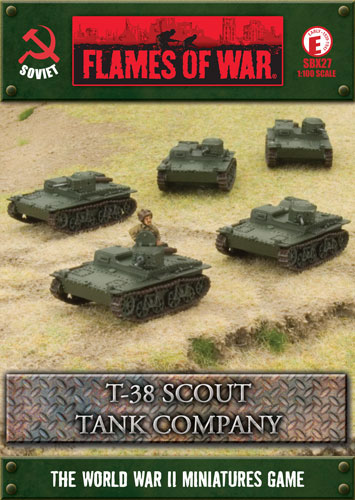
|
The BT tanks are based on the American designed Christie tank and can operate with or without its tracks fitted. The BT-5 mounts a 45mm gun in a similar turret to the T-26 obr 1933. The BT-7 is an improved model with a new turret and improved armour. The BT fast tanks have good speed that can be utilised by brave patriots to out manoeuvre the enemy and get behind his flanks to take advantage of their weak rear armour.
The T-60 is a new tank. It is armed with a 20mm cannon, it is lighter, and has a lower profile than the older models. However, it only requires two crew.
Units are big, with up to 16 tanks in each company. However, many of them did not arrive on the battlefield due to mechanical breakdowns, so it is more common to see companies of eight, nine, or ten tanks in the field.
|
Below: The uparmoured T-26E turret.
|
Below: The T-60 obr 1941.
|
Below: The T-26 obr 1932.
|
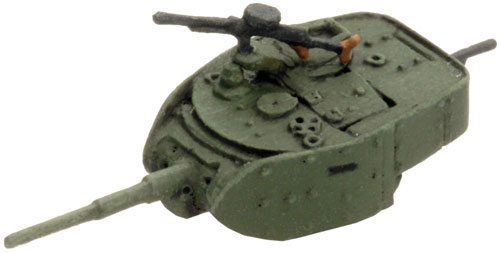 |
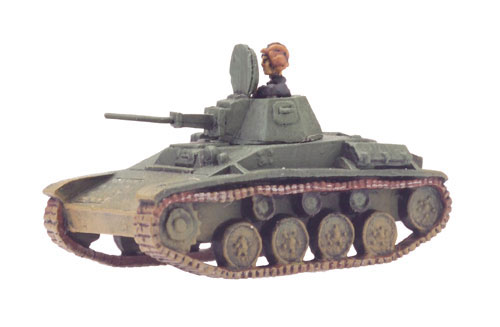 |
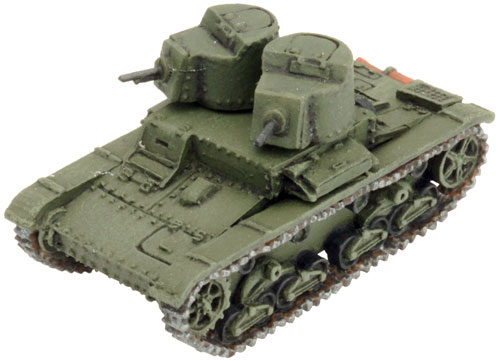
|
| The Soviet Light Tanks in Barbarossa |
| |
|
|
Armour
|
|
|
| Name |
Mobility |
Front |
Side |
Top |
Equipment and Notes |
| Weapon |
Range
|
ROF
|
Anti-tank
|
Firepower
|
|
| T-38 |
Half-tracked
|
0
|
0
|
1
|
MG, Amphibious, Limited vision, Unreliable.
|
T-60 obr 1941
|
Half-tracked |
2 |
1 |
1
|
Co-ax MG, Limited vision, Unreliable. |
20mm ShVAK gun
|
16"/40cm |
2
|
5
|
5+
|
|
| T-26 obr 1932
|
Slow Tank |
1
|
1
|
1
|
Twin MG turret, Limited vision, Unreliable. |
T-26 obr 1933 or 1939
|
Slow Tank |
1 |
1 |
1
|
Co-ax MG, Limited vision, Unreliable. |
45mm obr 1934 gun
|
24"/60cm |
2
|
7
|
4+
|
. |
T-26E
|
Very Slow Tank
|
3
|
2
|
1
|
Co-ax MG, Limited vision, Overloaded, Unreliable |
| 45mm obr 1934 gun |
24"/60cm |
2
|
7
|
4+
|
|
BT-5
|
Standard Tank
|
0
|
0
|
1
|
Co-ax MG, Fast tank Limited vision, Overloaded, Unreliable. |
| 45mm obr 1938 gun |
24"/60cm |
2 |
7
|
4+ |
|
| BT-7 |
Standard Tank |
1
|
1
|
1
|
Co-ax MG, Fast tank Limited vision, Overloaded, Unreliable. |
| 45mm obr 1938 gun |
24"/60cm |
2 |
7
|
4+
|
|
|
The Medium Tanks
The new T-34 tanks were issued to a number of tank divisions in the mechanised corps, and the Germans began to run into them within the first few days of the invasion. The T-34 caused the Germans to often avoid direct engagement with this well-armoured tank and powerful 76mm gun.
|
Below: The T-28.
|
Below: The uparmoured T-28E turret. |
Below: The T-34 obr 1941. |
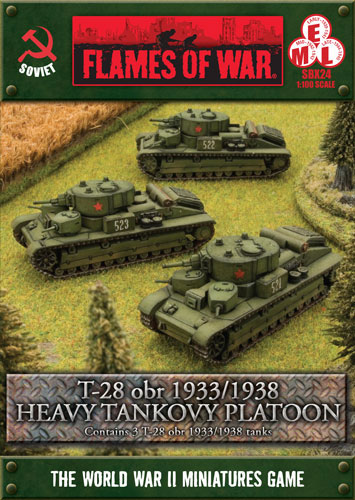 |
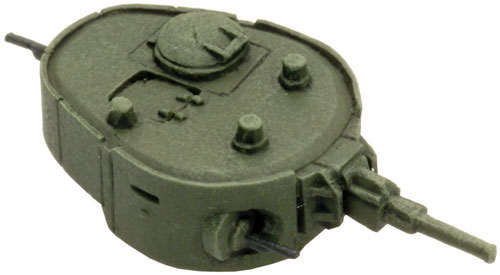
|
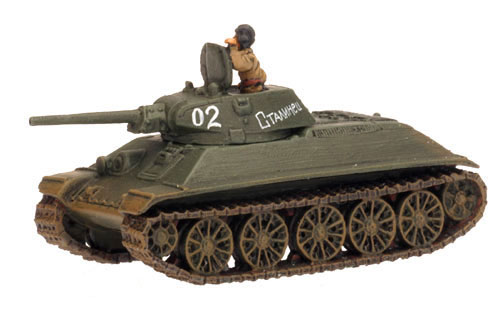 |
The Medium Tankovy Companies are armed with the T-28 medium tank. Though replaced in production by the new T-34 and KV tanks, the Red Army still has stocks of these tanks in 1941. Most Mechanised Corps still have a few companies of them in their arsenals.
|
The T-34
Field a platoon of T-34 tanks and watch the enemy panzers scurry away. Your Front Armour of 6 is virtually impenetrable to most of their weapons and with options for Anti-tank 8, 9 or 11 (depending on the version you choose to field) you can destroy any German tank. These are the Tigers of Early War!
|
| The Soviet Medium Tanks in Barbarossa |
| |
|
|
Armour
|
|
|
| Name |
Mobility |
Front |
Side |
Top |
Equipment and Notes |
| Weapon |
Range
|
ROF
|
Anti-tank
|
Firepower
|
|
T-28 obr 1933
|
Standard Tank
|
3
|
2
|
2
|
Two Deck-turret MG, Turret-front MG, Turret-rear MG, Limited vision, Unreliable, Wide tracks.
|
76mm obr 1927/32 gun
|
16"/40cm |
2
|
5
|
3+
|
|
| T-28 obr 1933
|
Standard Tank |
3 |
2 |
2
|
Two Deck-turret MG, Turret-front MG, Turret-rear MG, Limited vision, Unreliable, Wide tracks. |
76mm L-10 gun
|
24"/60cm |
2
|
7
|
3+
|
|
| T-28E
|
Slow Tank |
4
|
3
|
2
|
Two Deck-turret MG, Turret-front MG, Turret-rear MG, Limited vision, Unreliable, Wide tracks. |
| 76mm L-10 gun |
24"/60cm |
2 |
7
|
3+
|
|
T-34 obr 1940
|
Standard Tank |
6 |
5 |
1
|
Co-ax MG, Hull MG, Fast tank Limited vision, Unreliable, Wide tracks. |
| 76mm L-11 gun
|
24"/60cm |
2
|
8
|
3+
|
. |
| T-34 obr 1941
|
Standard Tank
|
6
|
5
|
1
|
Co-ax MG, Hull MG, Fast tank Limited vision, Unreliable, Wide tracks. |
| 76mm F-34 gun |
32"/80cm |
2
|
9
|
3+
|
|
T-34/57 obr 1941
|
Standard Tank
|
6
|
5
|
1
|
Co-ax MG, Hull MG, Fast tank Limited vision, Unreliable, Wide tracks. |
| 57mm ZIS-4 gun |
32"/80cm |
2 |
11
|
4+ |
|
|
The Heavy Tanks
In the 1920s and 1930s many European nations valued the idea of multi-turreted heavy breakthrough tanks, and the T-35 was the Soviet Union’s take on this concept. The T-35 heavy tank mounted five turrets, a main turret fitted with a 76mm gun, two 45mm gun armed turrets and two machine-gun turrets. The T-35 was a massive tank with crew compartments separated from each other. This often caused the crews of T-35 tanks to fight on when other tanks’ crews would have long given up.
|
The KV tank was a new type of heavy tank, a rejection of the multi-turreted designs like the T-35 and T-28 that had dominated the 1930s. During combat tests against the Finns during the Winter War, the new design proved itself superior to multi-turreted SMK and T-100 designs. In 1939 a production run of 50 was ordered. When Operation Barbarossa began, the Red Army had 508 new KV tanks. So effective was its armour that the Germans were incapable of destroying it with their tanks or anti-tank weapons and had to rely on pioneers with anti-tank mines, 8.8cm FlaK36 anti-aircraft guns, or s10cm K18 guns to knock them out. German advances were brought to a halt while pioneers or guns were moved up to deal with the seemingly immovable obstacles. On 23 June 1941 a single KV-2 tank of 3rd Mechanised Corps held up the entire 6. Panzerdivision for one day during the Battle of Raseiniai.
|
| The Soviet Heavy Tanks in Barbarossa |
| |
|
|
Armour
|
|
|
| Name |
Mobility |
Front |
Side |
Top |
Equipment and Notes |
| Weapon |
Range
|
ROF
|
Anti-tank
|
Firepower
|
|
T-35
|
Slow Tank
|
3
|
3
|
2
|
Two Deck-turret MG, Turret-front MG, Turret-rear MG, Land battleship, Overloaded, Unreliable.
|
76mm obr 1927/32 gun
|
16"/40cm |
2
|
5
|
3+
|
|
| 45mm obr 1934 gun |
24"/60cm
|
2
|
7
|
4+
|
Deck turret, Co-ax MG.
|
| 45mm obr 1934 gun |
24"/60cm |
2 |
7 |
4+ |
Deck turret, Co-ax MG.
|
| KV-1 obr 1939
|
Slow Tank |
8 |
7 |
2
|
Co-ax MG, Hull MG, Turret-rear MG, Limited vision, Unreliable. |
76mm L-11 gun
|
24"/60cm |
2
|
8
|
3+
|
|
| KV-1 obr 1940 |
Slow Tank |
8
|
7
|
2
|
Co-ax MG, Hull MG, Turret-rear MG, Limited vision, Unreliable. |
| 76mm F-34 gun |
32"/80cm |
2 |
9
|
3+
|
|
| KV-1e |
Slow Tank |
9 |
8 |
2
|
Co-ax MG, Hull MG, Turret-rear MG, Limited vision, Unreliable. |
| 76mm F-34 gun |
32"/80cm |
2
|
9
|
3+
|
. |
| KV-2
|
Slow Tank
|
8
|
7
|
2
|
Hull MG, Turret-rear MG, Limited vision, Unreliable. |
152mm obr 1938/40 howitzer
|
24"/60cm |
1
|
10
|
1+
|
Bunker buster.
|
|
Last Updated On Monday, October 6, 2014 by Blake at Battlefront
|
|